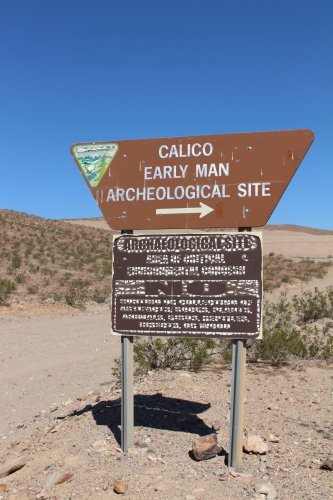Mystery Of Ancient, Overlooked Calico: Early Man Site In The Mojave Desert Of North America
Ellen Lloyd – AncientPages.com - One of North America's strangest and most controversial archaeological sites is the Calico Early Man. site. It is located midway between Los Angeles and Las Vegas and, more precisely, just outside Barstow's town in San Bernardino County in the central Mojave Desert of southern California.
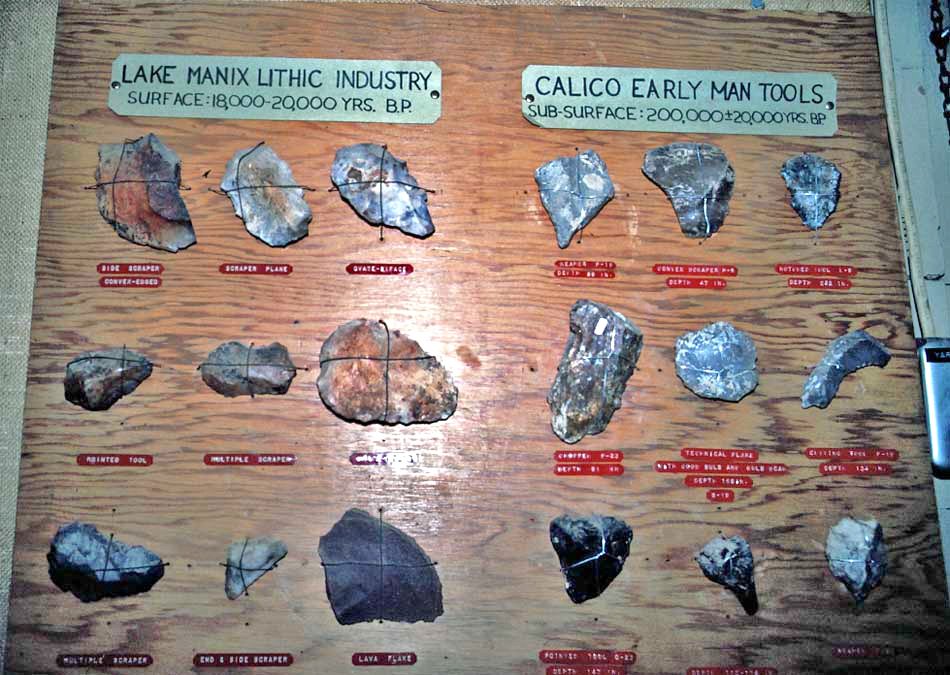 Some of the fragments, discovered at the Calico Early Man site. Image credit: www.barstowca.org
Some of the fragments, discovered at the Calico Early Man site. Image credit: www.barstowca.org
Is the Calico Early Man site one of North America's most overlooked ancient sites?
In 1942, amateur archaeologists discovered what they believed to be primitive stone tools in this area, but were the "tools" made by humans or through typical geological processes?
Are We Dealing With Stone Tools Made By Humans Or Geofacts?
Thousands of rocks that strongly resemble prehistoric tools were found at the site. The fragments were embedded in the sediments of the shoreline of an ancient Pleistocene Era lake called Lake Manix.
A stone from the Master Pit had been dated to over 200,000 BP (Before the Present). However, several scientists point out this date could have been the result of contamination from other elements in the soil, so currently, there is an effort to date verified lithics through thermoluminescence dating.
Credit: TopWorldImages
While the results are pending, the styles suggest 20,000 to 30,000 BP.
Dr. Leakey Found Intriguing Fragments
Dr. Louis S.B. Leakey (1903-1972), a Kenyan paleontologist and archaeologist, considered the Calico Early Man site to be of great archaeological importance and studied the area.
According to Dr. Leakey, thousands of artifacts found in this barren desert environment were eerily similar in appearance and manufacture to those he found in Africa. This striking similarity intrigued and mystified him.
Dr. Leakey was, in many ways, a remarkable scientist. His first crucial African discovery (in 1948) was the skull of a Miocene hominoid, which he named Proconsul africanus. Today, it is believed that this ape-like creature lived from approximately 23 to 14 million years ago and was likely a common ancestor of both humans and other primate species. Most of Dr. Leakey's significant discoveries were found in northern Tanzania at Olduvai Gorge. This area is affluent in fossils because of its unique geological history.
Dr. Leakey uncovered over 100 forms of extinct animal life at Olduvai Gorge. The debate over the proper interpretation of many Leakey finds continues today, but no one questions Louis Leakey's enormous contribution to human knowledge about the rise of our species.
Critics of Dr. Leakey have suggested his interest in the Calico Early Man site was not entirely genuine. These critics maintain that Dr. Leakey, coming to the end of his life and career, felt left out and forgotten as the archaeological world had moved on to discuss other finds and other scientists.
Astonishing discovery at a site like Calico Early Man could bring his name into the limelight.
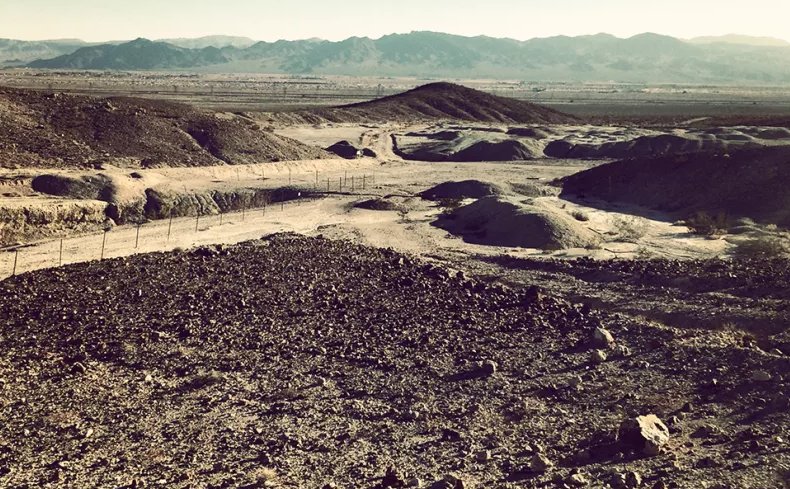 Did humans settle on the shores of the ancient Pleistocene lake more than 30,000 years ago? Credit: Public Domain
Did humans settle on the shores of the ancient Pleistocene lake more than 30,000 years ago? Credit: Public Domain
Whether it's true is uncertain, but Dr. Leakey was, without a doubt, a very competent researcher, and he found the Calico Early Man site worth investigating.
They examined previous findings for now, believing that some show enough evidence to rule them out as geofacts. However, these findings need to be published and undergo peer review before it can be determined whether the site shows clear evidence of prehistoric human habitation.
Because of the potentially ancient age of the artifacts, The Calico Early Man Site has always been highly controversial in archaeology.
If the artifacts are indeed prehistoric stone tools, then it means humans settled on the shores of the ancient Pleistocene lake more than 30,000 years ago.
It would also mean that the Calico Early Man Site is one of North America's most essential and overlooked historic sites.
The Calico Early Man site remains an unexplained archaeological mystery.
A bizarre and strange monument in America can be found in northeastern Georgia, North America. It is the Georgia Guidestones - an ominous monolith with stone tablets inscribed with directions for rebuilding civilization after the apocalypse.
Written by - Ellen Lloyd – AncientPages.com
Updated on March 5, 2024
Copyright © AncientPages.com All rights reserved. This material may not be published, broadcast, rewritten or redistributed in whole or part without the express written permission of AncientPages.com
Expand for referencesMore From Ancient Pages
-
 Forgotten And Overgrown Step Pyramid Of Koh Ker – Ancient Memory Of The Khmer Empire
Featured Stories | Apr 19, 2017
Forgotten And Overgrown Step Pyramid Of Koh Ker – Ancient Memory Of The Khmer Empire
Featured Stories | Apr 19, 2017 -
 Ancient Egyptian Cosmetics – Why Was It So Important To Both Men And Women?
Ancient History Facts | May 19, 2020
Ancient Egyptian Cosmetics – Why Was It So Important To Both Men And Women?
Ancient History Facts | May 19, 2020 -
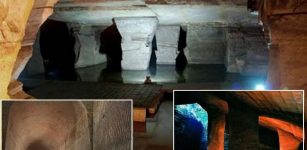 Underground Man-Made Longyou Grottoes Remain An Ancient Unsolved Mystery
Ancient Technology | Jan 16, 2019
Underground Man-Made Longyou Grottoes Remain An Ancient Unsolved Mystery
Ancient Technology | Jan 16, 2019 -
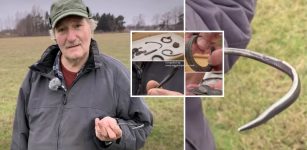 Silver Needle Dismissed As Trash Was Part Of A Stunning Viking Treasure Found By Farmer On Gotland
Archaeology | Nov 17, 2020
Silver Needle Dismissed As Trash Was Part Of A Stunning Viking Treasure Found By Farmer On Gotland
Archaeology | Nov 17, 2020 -
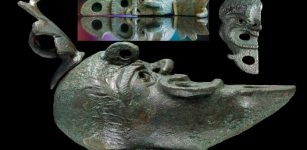 Rare Bronze Oil Lamp With A Face Cut In Half Unearthed In Israel
Archaeology | May 7, 2021
Rare Bronze Oil Lamp With A Face Cut In Half Unearthed In Israel
Archaeology | May 7, 2021 -
 Is A Viking Ship Hidden In The Colorado Desert?
Featured Stories | Jan 8, 2018
Is A Viking Ship Hidden In The Colorado Desert?
Featured Stories | Jan 8, 2018 -
 Amazing Archaeological Discovery In A Secret Underground Structure In Transylvania Could Rewrite Ancient History
Featured Stories | Feb 13, 2024
Amazing Archaeological Discovery In A Secret Underground Structure In Transylvania Could Rewrite Ancient History
Featured Stories | Feb 13, 2024 -
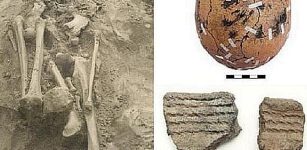 Eastern Baltic’s Communities Of First Farmers And Hunter-Gatherers Merged Slowly
Archaeology | Dec 10, 2023
Eastern Baltic’s Communities Of First Farmers And Hunter-Gatherers Merged Slowly
Archaeology | Dec 10, 2023 -
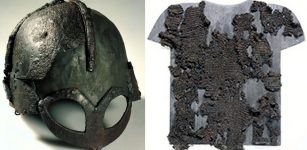 Unique Gjermundbu Helmet – Why Has Only One Viking Age Helmet Been Found In Scandinavia?
Artifacts | Mar 23, 2018
Unique Gjermundbu Helmet – Why Has Only One Viking Age Helmet Been Found In Scandinavia?
Artifacts | Mar 23, 2018 -
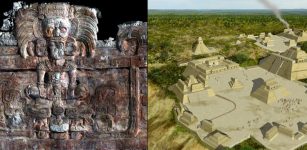 Spectacular Discovery Of Ancient Tombs Beneath Maya Pyramids Can Unravel The Mystery Of The Snake Kings
Archaeology | Oct 17, 2016
Spectacular Discovery Of Ancient Tombs Beneath Maya Pyramids Can Unravel The Mystery Of The Snake Kings
Archaeology | Oct 17, 2016 -
 New Models Shed Light On Life’s Origin
DNA | Feb 13, 2023
New Models Shed Light On Life’s Origin
DNA | Feb 13, 2023 -
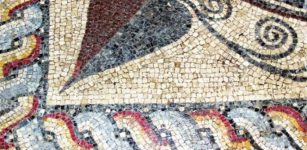 1,800-Year-Old Villa Of Famous Ancient Fisherman Phainos Unearthed In Turkey
Archaeology | Jun 20, 2018
1,800-Year-Old Villa Of Famous Ancient Fisherman Phainos Unearthed In Turkey
Archaeology | Jun 20, 2018 -
 The Lycurgus Cup: Fascinating Artifact That Reveals Prehistoric Knowledge Of Nanotechnology
Ancient Technology | Aug 2, 2018
The Lycurgus Cup: Fascinating Artifact That Reveals Prehistoric Knowledge Of Nanotechnology
Ancient Technology | Aug 2, 2018 -
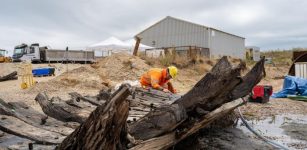 Rare Unexpected Discovery Of Elizabethan-Era Ship At Quarry 300 Meters From The Coast
Archaeology | Jan 2, 2023
Rare Unexpected Discovery Of Elizabethan-Era Ship At Quarry 300 Meters From The Coast
Archaeology | Jan 2, 2023 -
 Queen Nefertari – Favorite Wife Of Ramses II The Great And Her Lavishly Decorated Tomb In The Valley Of The Queens
Featured Stories | May 22, 2020
Queen Nefertari – Favorite Wife Of Ramses II The Great And Her Lavishly Decorated Tomb In The Valley Of The Queens
Featured Stories | May 22, 2020 -
 Vetala – Vampire With Knowledge Of The Past, Present And Future In Hindu Mythology
Featured Stories | Jan 19, 2021
Vetala – Vampire With Knowledge Of The Past, Present And Future In Hindu Mythology
Featured Stories | Jan 19, 2021 -
 Ancient Sophisticated Technologies: Mercury-Based Gilding That We Still Can’t Reach
Ancient Technology | Aug 1, 2018
Ancient Sophisticated Technologies: Mercury-Based Gilding That We Still Can’t Reach
Ancient Technology | Aug 1, 2018 -
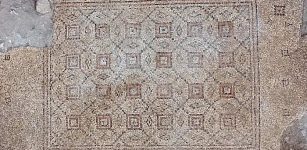 A 1,600-Year-Old Mosaic Accidentally Unearthed In Ancient City Of Yavne, Israel
Archaeology | Apr 26, 2021
A 1,600-Year-Old Mosaic Accidentally Unearthed In Ancient City Of Yavne, Israel
Archaeology | Apr 26, 2021 -
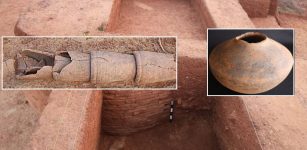 2,000-Year-Old Trade Center: Brick Structure, A Vishnu Sculpture Among Findings In Andhra Pradesh
Archaeology | Nov 6, 2019
2,000-Year-Old Trade Center: Brick Structure, A Vishnu Sculpture Among Findings In Andhra Pradesh
Archaeology | Nov 6, 2019 -
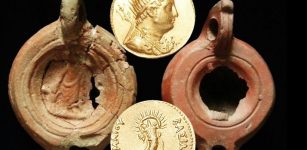 Greco-Roman Bath Complex, Coin Depicting King Ptolemy III And Other Artifacts Found In Egypt’s Gharbia Province
Archaeology | May 26, 2018
Greco-Roman Bath Complex, Coin Depicting King Ptolemy III And Other Artifacts Found In Egypt’s Gharbia Province
Archaeology | May 26, 2018

